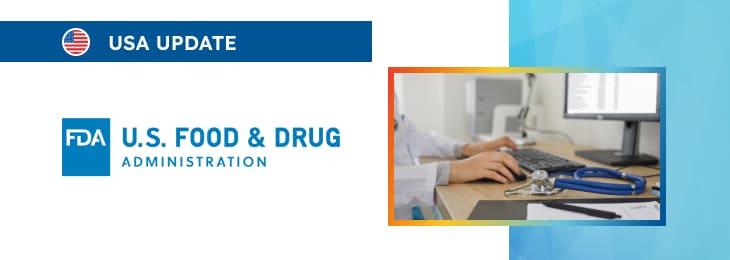The new article explains the matters related to general medical product communication in the context of addressing misinformation about the products.

Table of content
The Food and Drug Administration (FDA or the Agency), the US regulating authority in the sphere of healthcare products, had published a guidance document dedicated to addressing misinformation about medical devices and prescription drugs allowed to be marketed and used in the country. Structured as a questions-and-answers document, the guidance highlights the key points related to the applicable regulatory requirements and also provides additional clarifications and recommendations to be taken into consideration by medical device manufacturers and other parties involved in order to ensure compliance.
At the same time, provisions of the guidance are non-binding in their legal nature, nor are they intended to introduce new rules or impose new obligations. Moreover, the authority explicitly states that an alternative approach could be applied, provided such an approach is in line with the existing legal framework and has been agreed with the authority in advance.
Introduction
The guidance document outlines various approaches through which firms can address misinformation about their approved or cleared medical products. While tailored responsive communications provide a specific pathway for countering misinformation, firms have numerous existing approaches, collectively referred to as general medical product communications, to disseminate accurate information.
The guidance discusses these general communication strategies, highlighting how they can be used to address misinformation, the types of communications available, and the relevant FDA guidance that firms should consider.

General Medical Product Communications
According to the guidance, firms can utilize a wide range of existing communication channels to address misinformation about their approved or cleared medical products. These general medical product communications encompass various methods of disseminating information, from promotional materials to more educational or awareness-focused communications.
It is important to mention that the inclusion of content that addresses misinformation within these general communications does not trigger special considerations under FDA enforcement policies, provided the communications adhere to existing FDA regulations and guidelines.
Promotional Communications
One of the most important types of general medical product communication is promotional communication. These are designed to provide information about a product’s safety and effectiveness, and they are often used to promote the approved uses of a medical product.
Under the general rule, promotional communications must comply with FDA regulations, ensuring that the information presented is truthful, non-misleading, and consistent with the FDA-required labeling. Promotional communications offer flexibility in how firms choose to address misinformation.
Firms can subtly counter misinformation by providing correct information without directly referencing the misinformation or, alternatively, they can explicitly identify and correct the misinformation. Moreover, promotional communications allow firms to present a broad range of information about the product, going beyond the narrow focus required in tailored responsive communications.
This approach can be particularly useful when misinformation is widespread and needs to be addressed comprehensively.
Flexibility in Communication Strategies
As further explained by the FDA, firms can craft their promotional communications to be effective across various settings, both internet-based and non-internet-based. This flexibility supports diverse strategies for reaching different audiences. For instance, a firm might choose to address widespread misinformation by using a combination of methods, such as direct-to-consumer advertising, engagement with healthcare professionals (HCPs), or leveraging influencers in online spaces.
As long as these promotional communications comply with FDA labeling and advertising requirements, there are no additional considerations imposed by the fact that they address misinformation.
Relevant FDA Guidance for Promotional Communications
The FDA has issued several guidance documents that provide recommendations for firms on how to structure their promotional communications effectively. For example, the Medical Product Communications That Are Consistent With the FDA-Required Labeling: Questions and Answers (June 2018) (CFL guidance) offers advice on how to present data and information that may not be included in the FDA-required labeling but is consistent with it.
This guidance emphasizes the importance of conveying information in a truthful and non-misleading manner. Additionally, the Presenting Quantitative Efficacy and Risk Information in Direct-to-Consumer (DTC) Promotional Labeling and Advertisements (December 2023) (Quant Info guidance) provides recommendations for making quantitative information more accessible to consumers.
The guidance suggests methods for presenting probability information, using visual aids, and formatting data in a way that enhances consumer understanding. These recommendations are particularly useful when addressing misinformation that may involve complex statistical or risk information.
Communications About Unapproved Uses
In some cases, firms may need to address misinformation related to unapproved uses of their approved/cleared medical products. The FDA has issued several documents that clarify when the dissemination of information about unapproved uses does not constitute evidence of intended use.
These guidelines will be applicable even when the dissemination of such information is aimed at correcting misinformation. For example, the draft guidance Communications From Firms to Health Care Providers Regarding Scientific Information on Unapproved Uses of Approved/Cleared Medical Products: Questions and Answers (October 2023) (SIUU guidance) provides insight into how firms can communicate scientific information about unapproved uses to healthcare providers without violating FDA regulations.
Institutional and Help-Seeking Communications
Another option for firms to address misinformation is through communications that are characterized as help-seeking or institutional. These types of communications do not reference specific medical products but instead focus on raising awareness about diseases or treatment options.
Such communications can be particularly useful in addressing broad misinformation that affects an entire class of products or treatments. Because these communications are distinct from promotional communications, they are subject to different regulatory considerations, offering firms additional flexibility in how they approach misinformation.
Conclusion
In summary, general medical product communications provide firms with a robust framework to address misinformation about their approved or cleared medical products. These existing approaches and methods complement the tailored responsive communications discussed in the enforcement policy, offering firms a wide range of tools to ensure that accurate, truthful information about their products reaches the public.
How Can RegDesk Help?
RegDesk is an AI-powered Regulatory Information Management System that provides medical device companies with regulatory intelligence for over 120 markets worldwide. It can help you prepare and publish global applications, manage standards, run change assessments, and obtain real-time alerts on regulatory changes through a centralized platform. Global expansion has never been this simple.

